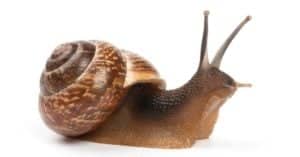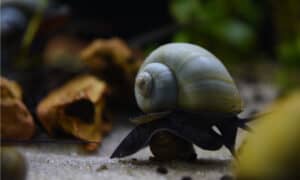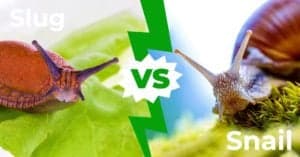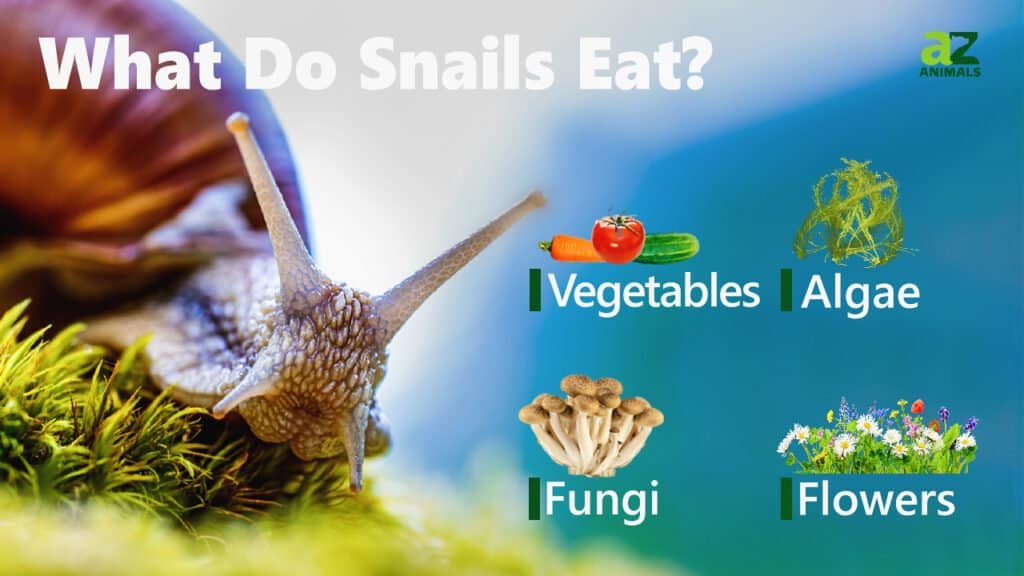
Snails are a fascinating and surprisingly diverse group of animals with over 43,000 known species and more being discovered all the time. A snail, technically speaking, is categorized as any gastropod mollusk that happens to have a shell. But what do snails eat, anyway? Additionally, how do they eat?
From land snails to sea and freshwater varieties, we’ll cover all of what snails eat in detail here. We’ll also go over how they use a unique feature known as a radula, a structure made up of thousands of tiny teeth, to break down and eat their food.
What Do Land Snails Eat?

A common garden
snail
munching on some lettuce
©Alexander Raths/Shutterstock.com
Land snails are classified as any type of snail that lives primarily on land, such as the common garden snail, Cornu aspersum. Although many species of land snails sometimes alternate between terrestrial and underwater living, their key feature is the fact that they spend the majority of their time on land.
Interestingly, land snails are able to eat just about anything their squishy little bodies can digest, from small insects to plants to animal waste. Some species are strictly carnivorous or herbivorous, but the majority are extreme omnivores that can subsist on a huge variety of organic material, even if it’s dead and decaying.
Here’s a list of the foods land snails commonly eat:
- Vegetables of all kinds
- Fruit of all kinds
- Grains
- Fungi
- Algae
- Grasses and leaves
- Tree bark
- Flowers
- Worms
- Animal waste
- Rotting vegetation
- Other snails
- Insects
How Do Land Snails Eat?
Land snails get from place to place to find food by flexing the muscles along their long, singular foot. They expel mucus from it to allow them to move over all kinds of rough surfaces without drying out. When they encounter something they want to eat, they use a structure attached to their jaw that is known as a radula.
A radula is sort of like a tongue with lots of tiny, sharp teeth called denticles covering its surface. Land snails use it to scoop up and cut their food into tiny pieces before swallowing it! Research on radulae function has shown that snails are even able to adjust the force of their radula scraping depending on what they’re eating!
What Do Sea Snails Eat?
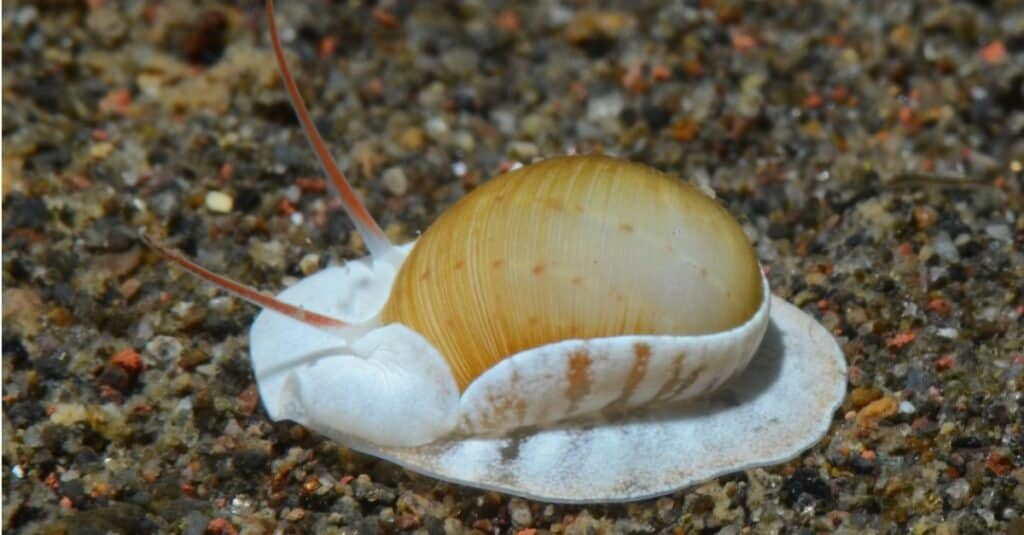
A sea snail scoots along the ocean floor
©iStock.com/Giorgio Cavallaro
Sea snails are perhaps even more diverse than their land-dwelling cousins, with tens of thousands of known species of varying sizes and shapes.
Ocean-dwelling snails use gills to breathe underwater and spend all of their time there, though there are a few species that can also breathe air by using a single lung. Most sea snails have spiral-shaped shells that they can hide inside of as a defense mechanism.
The majority of known sea snail species are herbivorous, meaning they feed on plant material underwater. There are a few species, however, such as the venomous cone snail, that also eat meat. The various foods sea snails eat include:
How Do Sea Snails Eat?
Most herbivorous sea snails also possess a radula that they use to scrape algae, seaweed, and other plants off of rocks and other surfaces along the ocean floor. The thousands of tiny denticles on the radula slowly scrape up plant material and then cut it up into bite-sized pieces small enough to fit down their esophagus.
Carnivorous sea snails, however, are a bit different. Many, like the cone snail, use venom or other unique methods to take down their food, such as the moon snail’s unique proboscis.
Moon snails tend to hide in the sand until an animal like a bivalve or another unfortunate snail passes by. Once their prey gets close enough, a moon snail will quickly envelop the animal before drilling a hole in it with a sharp proboscis. They then use their proboscis to suck out the animal’s organs and flesh for them to eat!
Other carnivorous snails like cone snails use their modified radulae to inject their prey with powerful venom before engulfing them and slowly eating them alive.
What Do Freshwater Snails Eat?

A New Zealand mud snail shows off its muscular foot and radula
©iStock.com/Heather Broccard-Bell
Freshwater snails are the third main group of snails, and they live in bodies of water such as lakes and rivers. There are around 5,000 species of freshwater-dwelling snails, most of which are either part of the Pulmonata or Prosobranchia subclasses.
Most freshwater snail species, such as Pomacea maculata (also known as apple snails), are primarily herbivorous, though some are also detritivorous, meaning they will also scavenge for decaying plant and animal matter. Some of the foods they eat include:
- Algae (again, lots of it!)
- Bacteria
- Live and decaying plant matter
- Aquatic vegetation like water lettuce
- Dead and decaying animal matter (such as other snails!)
How Do Freshwater Snails Eat?
Freshwater snails eat in a similar manner to most species of sea snails. They use their radulae to slowly peel traces of algae, bacteria, and other organic material off of rocks and plants.
Most freshwater snails graze throughout the day on all kinds of organic matter, both dead and living. Like their ocean-living counterparts, they mostly feed on various kinds of algae and vegetation.
The photo featured at the top of this post is © iStock.com/Giorgio Cavallaro
Thank you for reading! Have some feedback for us? Contact the AZ Animals editorial team.




